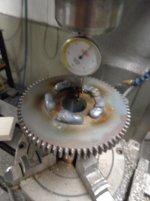vettebob
Cast Iron
- Joined
- Aug 4, 2008
- Location
- Blue Springs MO
Follow along with the video below to see how to install our site as a web app on your home screen.
Note: This feature may not be available in some browsers.

... One set the reversing set is burned up, the motor generator is one of the very rare 2 phase models. The ways saddle and tailstock all are worn. The spindle is different from the drawings monarch sent. It has 2Timkin tapered roller bearings one in the front and one in the back. The machine was a former Westinghouse Lathe built in 1944. The guy I purchased it from said he was told it was used to turn commutators. I think I just accidentaly discovered why it was sold. The spindle bearings were a bit loose so I started taking the headstock cover off and looked inside. ...




 Repaired my 6 to 1 output gear today I used a ER100s alloy rod for good hard teeth when I welded it. My welding isn't to good I'm still learning how to use my tig welder. The dogs came out well they dulled a new m42 cobalt end mill in 30 seconds. I machined the other teeth with carbide end mill. Here's some pics. Bob
Repaired my 6 to 1 output gear today I used a ER100s alloy rod for good hard teeth when I welded it. My welding isn't to good I'm still learning how to use my tig welder. The dogs came out well they dulled a new m42 cobalt end mill in 30 seconds. I machined the other teeth with carbide end mill. Here's some pics. BobI've also been doing body work on the lathe main casting while I wait for my ways to be ground. BobView attachment 96089View attachment 96090View attachment 96091View attachment 96092
Notice
This website or its third-party tools process personal data (e.g. browsing data or IP addresses) and use cookies or other identifiers, which are necessary for its functioning and required to achieve the purposes illustrated in the cookie policy. To learn more, please refer to the cookie policy. In case of sale of your personal information, you may opt out by sending us an email via our Contact Us page. To find out more about the categories of personal information collected and the purposes for which such information will be used, please refer to our privacy policy. You accept the use of cookies or other identifiers by closing or dismissing this notice, by scrolling this page, by clicking a link or button or by continuing to browse otherwise.
